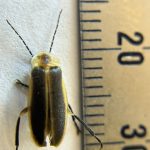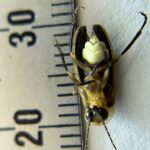Notice: Below is a list of 0 important links included on this page.
Please note that while screen readers have made significant strides, they may still lack full support for optimal web accessibility.



You must be logged in to post a comment.
This is a project of the Xerces Society, working in collaboration with the IUCN SSC Firefly Specialist Group and New Mexico BioPark Society.
Copyright © 2025 The Xerces Society •1631 NE Broadway Street, #821 • Portland OR 97232 USA
A very belated thank you for this observation, Allen!
I am intrigued by this observation, and while I do see some similarities with Photuris frontalis, the longer flash pattern period and the lack of stigmatiform pits make me reluctant assign P. frontalis as the ID.
The photos and flash pattern remind me of Photuris polacekae which has a bare-bones description based off a single Gillispie County specimen in Lloyd’s 2018 Photuris monograph:https://entnemdept.ufl.edu/Lloyd/Firefly/Lloyd_2018.pdf.
Clearly, Photuris in Texas need more study!